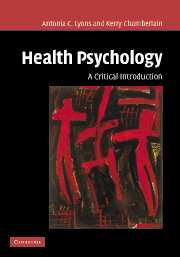Book contents
- Frontmatter
- Contents
- Acknowledgements
- Setting out: using this book
- 1 Locating the field: introducing health psychology
- 2 Thinking about health and the body
- 3 Choosing lifestyles
- 4 Controlling the body
- 5 Becoming ill
- 6 Comprehending bodily experience
- 7 Interacting with health professionals
- 8 Treating illness
- 9 Being ill
- 10 Dying
- 11 Relocating the field: critical health psychology
- Glossary
- References
- Author index
- Subject index
- References
6 - Comprehending bodily experience
Published online by Cambridge University Press: 05 June 2012
- Frontmatter
- Contents
- Acknowledgements
- Setting out: using this book
- 1 Locating the field: introducing health psychology
- 2 Thinking about health and the body
- 3 Choosing lifestyles
- 4 Controlling the body
- 5 Becoming ill
- 6 Comprehending bodily experience
- 7 Interacting with health professionals
- 8 Treating illness
- 9 Being ill
- 10 Dying
- 11 Relocating the field: critical health psychology
- Glossary
- References
- Author index
- Subject index
- References
Summary
The symptom itself is rarely questioned. But is the symptom so unproblematic? Why does one person experience headaches and sore throats whereas another has migraines and tonsillitis? Why does retirement exacerbate symptoms but a busy job make them disappear? … An understanding of how symptoms arise and how only some are given the status of a problem can create a broader psychological perspective in which to understand patients' health and illness.
(Ogden, 2003a, p. 409)An essential characteristic of physical sensations [are that] they are as often socially influenced interpretations as they are the direct output of a biological system. In matters of health and illness, it is difficult to imagine a more fundamental process than that by which we perceive, interpret, and act on the information from our own bodies.
(Cioffi, 1991, p. 25)Learning objectives
The aim of this chapter is to review the literature on how people interpret and respond to bodily sensations which have implications for physical health. By the end of this chapter you should be able to:
provide an overview of psychological research on recognising symptoms;
offer a critique of the biomedical model of symptom recognition;
distinguish between a ‘bodily sign’ and a ‘physical symptom’;
argue why cognitive factors involved in perceiving changes in bodily states need to be understood within a social and cultural framework;
describe and critique the main theories of pain;
discuss the implications of constructing factors that influence bodily experience as located within the individual;
compare and contrast differing accounts of the body and bodily experience.
- Type
- Chapter
- Information
- Health PsychologyA Critical Introduction, pp. 181 - 206Publisher: Cambridge University PressPrint publication year: 2006



